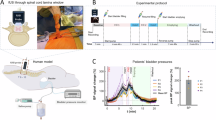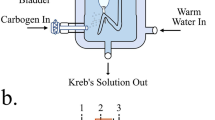Abstract
Study design:
Retrospective descriptive study.
Objective:
Although muscarinic receptors are the main targets for the treatment of detrusor overactivity today, anticholinergic therapy is not satisfying in a substantial percentage of patients. Recently, overexpression of P2X2 receptors in patients with idiopathic overactive bladder was demonstrated, indicating that purinergic innervation may play an important role in the pathophysiology of detrusor overactivity. We evaluated the expression of P2X2 receptors in patients with spinal cord lesions.
Setting:
German university hospital.
Methods:
By immunohistochemical staining, the frequency and intensity of P2X2 expression in bladder specimens from 15 patients with suprasacral spinal cord lesion were compared to those from 11 patients with bladder disorders not related to spinal cord injury (overactive bladder: n=6; chronic non-obstructive retention: n=2; bladder tumour: n=3).
Results:
Specimens (12/15) from patients with spinal cord lesions and specimens (8/11) without spinal cord lesions demonstrated staining for P2X2 receptors in the detrusor muscle and the urothelium. There was a tendency towards a stronger staining in specimens from patients with spinal cord lesion.
Conclusion:
Our pilot study gives a first hint that the P2X2 expression in patients with suprasacral spinal cord injury seems to be comparable to the expression in patients with idiopathic overactive bladder. Therefore, P2X2 receptors in detrusor tissue may be a future target for the treatment of detrusor overactivity.
Similar content being viewed by others
Log in or create a free account to read this content
Gain free access to this article, as well as selected content from this journal and more on nature.com
or
References
de Groat WC, Kawatani M, Hisamitsu T, Cheng CL, Ma CP, Thor K et al. Mechanisms underlying the recovery of urinary bladder function following spinal cord injury. J Auton Nerv Syst 1990; 30 (Suppl): 71–77.
Gerridzen RG, Thijssen AM, Dehoux E . Risk factors for upper tract deterioration in chronic spinal cord injured patients. J Urol 1992; 147: 416–418.
Perkash I . Long-term urologic management of the patient with spinal cord injury. Urol Clin North Am 1993; 20: 423–434.
Nosseir M, Hinkel A, Pannek J . Clinical usefulness of urodynamic assessment for maintenance of bladder function in patients with spinal cord injury. Neurourol Urodyn 2007; 26: 228–233.
Inoue R, Brading AF . Human, pig and guinea-pig bladder smooth muscle cells generate similar inward currents in response to purinoceptor activation. Br J Pharmacol 1991; 103: 1840–1841.
Rapp DE, Lyon MB, Bales GT, Cook SP . A role for the P2X receptor in urinary tract physiology and in the pathophysiology of urinary dysfunction. Eur Urol 2005; 48: 303–308.
Tempest HV, Dixon AK, Turner WH, Elneil S, Sellers LA, Ferguson DR . P2X and P2X receptor expression in human bladder urothelium and changes in interstitial cystitis. BJU Int 2004; 93: 1344–1348.
O’Reilly BA, Kosaka AH, Knight GF, Chang K, Ford APDW, Rymer JM et al. P2X receptors and their role in female idiopathic detrusor instability. J Urol 2002; 167: 157–164.
Moore KH, Ray FR, Barden JA . Loss of purinergic P2X(3) and P2X(5) receptor innervation in human detrusor from adults with urge incontinence. J Neurosci 2001; 21: 17–22.
Harvey RA, Skennerton DE, Newgreen D, Fry CH . The contractile potency of adenosine triphosphate and ecto-adenosinetriphosphatase activity in guinea pig detrusor and detrusor from patients with a stable, unstable or obstructed bladder. J Urol 2002; 168: 1235–1239.
Brady CM, Apostolidis A, Yiangou Y, Baecker PA, Ford AP, Freeman A et al. P2X3-immunoreactive nerve fibres in neurogenic detrusor overactivity and the effect of intravesical resiniferatoxin. Eur Urol 2004; 46: 247–253.
Apostolidis A, Popat R, Yiangou Y, Cockayne D, Ford AP, Davis JB et al. Decreased sensory receptors P2X3 and TRPV1 in suburothelial nerve fibers following intradetrusor injections of botulinum toxin for human detrusor overactivity. J Urol 2005; 174: 977–982.
Bayliss M, Wu C, Newgreen D, Mundy AR, Fry CH . A quantitative study of atropine-resistant contractile responses in human detrusor smooth muscle, from stable, unstable and obstructed bladders. J Urol 1999; 162: 1833–1839.
O’Reilly BA, Kosaka AH, Chang TK, Ford AP, Popert R, Rymer JM et al. A quantitative analysis of purinoceptor expression in human fetal and adult bladders. J Urol 2001; 165: 1730–1734.
O’Reilly BA, Kosaka AH, Chang TK, Ford AP, Popert R, McMahon SB . A quantitative analysis of purinoceptor expression in the bladders of patients with symptomatic outlet obstruction. BJU Int 2001; 87: 617–622.
Ford APDW, Gever JR, Nunn PA, Zhong Y, Cefalu JS, Dillon MP et al. Purinoceptors as therapeutic targets for lower urinary tract dysfunction. Br J Pharmacol 2006; 147: S132–S143.
Lee HY, Bardini M, Burnstock G . Distribution of P2X receptors in the urinary bladder and the ureter of the rat. J Urol 2000; 163: 2002–2007.
Radley SC, Rosario DJ, Chapple CR, Farkas AG . Conventional and ambulatory urodynamic findings in women with symptoms suggestive of bladder overactivity. J Urol 2001; 166: 2253–2258.
Lu SH, Groat WC, Lin AT, Chen KK, Chang LS . Evaluation of purinergic mechanism for the treatment of voiding dysfunction: a study in conscious spinal cord-injured rats. J Chin Med Assoc 2007; 70: 439–444.
Author information
Authors and Affiliations
Corresponding author
Rights and permissions
About this article
Cite this article
Pannek, J., Janek, S., Sommerer, F. et al. Expression of purinergic P2X2-receptors in neurogenic bladder dysfunction due to spinal cord injury: a preliminary immunohistochemical study. Spinal Cord 47, 561–564 (2009). https://doi.org/10.1038/sc.2008.165
Received:
Revised:
Accepted:
Published:
Issue date:
DOI: https://doi.org/10.1038/sc.2008.165
Keywords
This article is cited by
-
The Management of Urine Storage Dysfunction in the Neurological Patient
SN Comprehensive Clinical Medicine (2019)
-
Effect of detrusor botulinum toxin a injection on urothelial dysfunction in patients with chronic spinal cord injury: a clinical and immunohistochemistry study before and after treatment
Spinal Cord (2016)
-
Purinergic signalling in the urinary tract in health and disease
Purinergic Signalling (2014)
-
Treatment of Neurogenic Voiding Dysfunction: An Update
Current Bladder Dysfunction Reports (2011)
-
Neurogenic Bladder: Current Pharmacologic Trends
Current Bladder Dysfunction Reports (2010)



